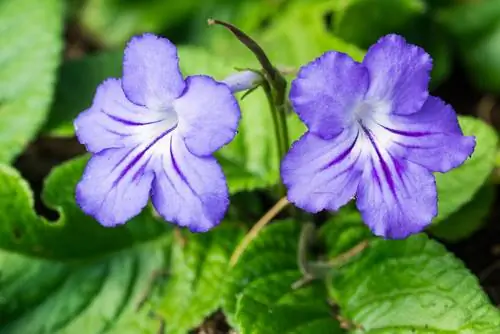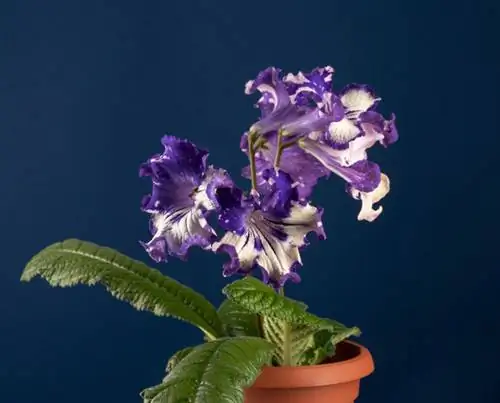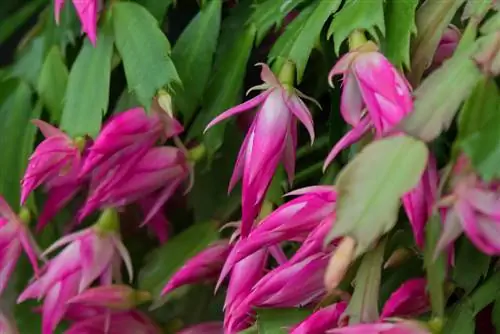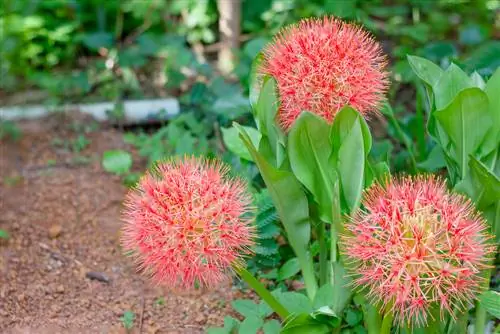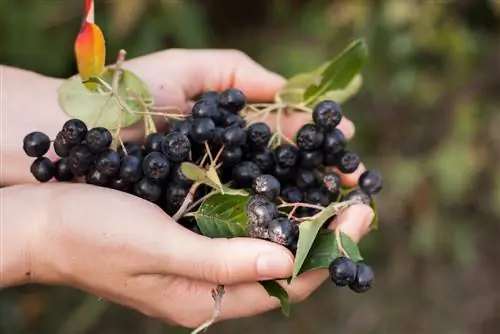- Author admin [email protected].
- Public 2024-01-05 20:48.
- Last modified 2025-01-23 11:21.
The rotary fruit (bot. Streptocarpus), also known as the velvet bell or because of its origin as the African violet, is a genus of plants from the Gesneriaceae family comprising around 135 different species. Many hybrid varieties are used as houseplants, but they are not entirely easy to care for.
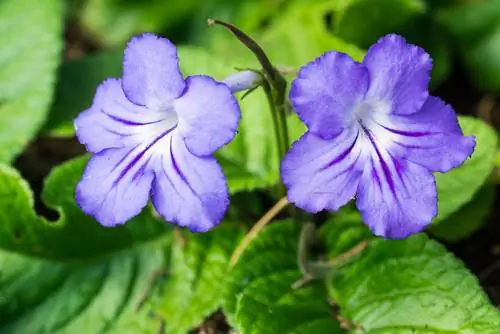
What is the rotary fruit and how to care for it?
The rotary fruit (Streptocarpus) is a tropical plant genus with around 135 species that are popular as houseplants. It prefers bright, warm and humid environments and produces persistently colorful flowers between April and September. Caring for this plant requires careful watering, fertilization and suitable winter conditions.
Origin and distribution
Most types of rotary fruit come from tropical Africa, where they are primarily at home in South Africa, Tanzania and Madagascar. Only four species of the genus have their home in Asia, such as Streptocarpus burmanicus in Myanmar, Streptocarpus orientalis in Thailand or Streptocarpus sumatranus on Sumatra.
Usage
Due to its tropical origins, the warmth-loving rotary fruit can only be cultivated as a houseplant or on the balcony or terrace during the hot summer months. Mainly various hybrid forms are used, although the specific species are very rare as houseplants.
Appearance and growth
The rotary fruit hybrids kept indoors are usually perennial and evergreen plants that grow herbaceously and do not become woody. Many popular varieties produce long shoot axes that hang over the edge of the planter. These rotary fruit varieties are perfect for planting in hanging baskets, where they can let their shoots grow downwards. Other varieties also develop quite long shoot axes, which, however, remain independently upright. These varieties can usually be easily cultivated on the windowsill. Streptocarpus usually only grows between ten and 20 centimeters high.
leaves
Many rotary fruit hybrids develop large, often finely hairy and elongated to elliptical shaped leaves that are arranged in basal rosettes. Some varieties (e.g. Streptocarpus wendlandii), however, only form a single leaf up to 90 centimeters long, which continues to grow or then dies after the formation of a new leaf/leaves. These leaves must not rest on the substrate, otherwise they will rot. As a rule, the leaves are green, but there are also varieties with variegated (i.e. multicolored) foliage.
Flowers and flowering time
The five-fold funnel flowers, which are reminiscent of orchids, appear between April and September, with the rotary fruit being a very persistent flowering plant - it constantly produces new flowers and is therefore very decorative. Depending on the variety, several or just a single flower grows on one stem. These can be monochromatic to multi-colored - the color palette is very extensive, especially for the hybrid forms, and ranges from white to red and pink to blue and violet in various tones.
Fruits and seeds
After the flowers, the cylindrically twisted fruits form, which gave the plant its name. The spiral capsules contain numerous, very fine seeds. You can extend the flowering period of the rotary fruit by removing spent stems in a timely manner and thus hindering fruit development. The plant will then invest its energy in the formation of new flowers.
Toxicity
The twist fruit is considered non-toxic. However, its leaf juice can cause an itchy rash in sensitive people.
Location and temperature
As a true tropical plant, the rotary fruit prefers a bright location with high humidity and a warm ambient temperature. If possible, place the pot directly in an east or west-facing window, as the plant needs light, but too much intense sunlight is harmful. If the plant faces south, you should provide shade during midday. In addition, the location should be airy but not drafty and warm at least 15 °C all year round. During the flowering period, the optimal temperature is 22 to 25 °C, with humidity at least 60 percent - preferably more.
Substrate
The pretty flowers only develop when the rotary fruit is placed in soil that suits its needs. In its natural habitat, the plant can be found in the loose, humus-rich soils of rainforests, which is why the potting substrate should be composed accordingly. For this purpose, mix humus-rich, peat-free potting soil (€16.00 on Amazon) about half with loose coconut soil.
Planting and repotting
The roots of the rotary fruit grow close to the surface of the substrate, and the root ball can become quite wide. Therefore, choose a wide plant pot instead of a deep one. The right time to repot is when the planter is well rooted.
Watering rotary fruit
Watering the rotary fruit correctly requires a certain amount of sensitivity, because the plant wants to be kept evenly moist - but only slightly, because excessive moisture and especially waterlogging has an extremely harmful effect. Always water when the top layer of substrate has dried, but the entire pot is not yet completely dry. Always check the necessity with a thumb test first. When watering, use room temperature rainwater or stale tap water and be careful not to wet the leaves and flowers. Always water from below and avoid spraying the rotary fruit as the leaves tend to rot. Remove excess water from the saucer or planter as soon as possible.
Fertilize rotating crops properly
Fertilize the rotary crop every 14 days between March and October with a liquid flowering plant fertilizer, which you administer together with the irrigation water. Never fertilize on dry substrate, always moisten it.
Cut rotary fruit correctly
Regular topiary is not necessary for rotary fruit. Only wilted, dried out and diseased plant parts should be removed regularly with a sharp and disinfected cutting tool, which can be done at any time. Do not simply tear off the relevant parts of the plant, as this makes it easier for fungi, bacteria and other pathogens to enter.
Propagate rotary fruit
As demanding as the rotary fruit is in terms of care, propagation is very uncomplicated. Above all, vegetative propagation via cuttings and leaf cuttings can be easily carried out even by laypeople.
Leaf cuttings
Naturally, leaf cuttings can only be obtained from species with multiple leaves, but the single-leaf rotary fruit species are unsuitable for this purpose. And this is how it works:
- Cut off a he althy leaf in spring.
- Cut this crosswise into three to four pieces.
- Place the partial leaves about a centimeter deep in the growing substrate.
- If necessary, support them with matches or other wooden sticks.
Place the plant pots in a bright and warm window seat and always keep the substrate slightly moist. Do not stretch foil or similar over the cuttings as this promotes rot. Instead, use willow water for irrigation as this encourages roots to develop. Within a few weeks, small rotary fruit plants with their own roots will form along the cut edges. Separate these from the leaf cuttings and pot them separately in their own pots from a height of approx. seven centimeters.
Cuttings
Hanging rotary fruit species and hybrids such as Streptocarpus saxorum are very suitable for propagation via shoot cuttings. And this is how you do it:
- Cut head cuttings seven to ten centimeters long in spring.
- Remove all but the top pair of leaves.
- Plant the cuttings individually in plant pots filled with growing medium.
You can also place these vessels in a bright and warm window seat. Keep the substrate evenly moist but not wet. As soon as strong roots have formed, the cutting will sprout again. Now repot it into a larger container if necessary.read more
Wintering
Proper wintering is the most difficult phase in the life of the rotary fruit. If you want to be on the safe side, simply leave the plant in its usual location and reduce the temperature here to around 15 °C. This approach is practical, but not necessarily practical, especially in the living room. In principle, the rotary fruit can be cultivated here all year round in warm temperatures, but there is a risk that the flowering will not occur if there is no vegetation break. So place it in a comparable but cooler place (e.g. in the bedroom), water it little and stop fertilizing from October. From February / March onwards, slowly get the plant used to warmer temperatures again.read more
Tip
You can create the right humid microclimate with a simple trick: Place the planter on a bowl filled with pebbles and water, but the roots must not hang in the water. Evaporation automatically increases the humidity to the desired high level, just don't forget to refill it regularly.
Species and varieties
There are around 135 different types of rotary fruit, some of which are also cultivated as houseplants. However, most indoor-grown varieties are specially bred hybrid varieties, of which there are several hundred different ones. To list them all here would go beyond the scope. We would of course be happy to introduce you to the most beautiful varieties.
Streptocarpus saxorum
This hanging-growing and very lushly flowering species originally comes from Tanzania and Kenya, but can also be kept well indoors. Most varieties produce bright blue flowers - for example the very popular variety 'Blue Paul' - but there are also white or pink flowering forms.
Streptocarpus candidus
This species, which comes from South Africa and is rarely cultivated here, delights with numerous pure white calyxes.
Streptocarpus wendlandii
This is a so-called single-leaf plant that only produces a single, but very large, leaf. Streptocarpus wendlandii blooms for a very long time and shows pretty purple flowers, but dies after flowering. The species comes from South Africa.
Streptocarpus parfuflora
This species also only produces a single leaf, but it is very long, up to 30 centimeters long. The plant, which also comes from South Africa, can grow up to 30 centimeters high and blooms very persistently. The newly formed flowers are white.
Streptocarpus hybrids
Outwardly, the numerous Streptocarpus hybrids are very different. Some varieties can grow very large and develop leaves up to 50 centimeters long, others have an upright growth habit, and still others have a prostrate or drooping habit. However, the differences are particularly large in the flower colors: single-colored varieties in a wide variety of shades are represented as well as two- or even three-colored varieties.
- 'Harlequin': growth height up to 35 centimeters, three-colored flowers
- 'Asia': growth height up to 30 centimeters, white flowers with ruffled edges
- 'Iona': deep red flowers, blooms up to ten months a year
- 'Roulette Cherry': growth height up to 35 centimeters, pink flowers with white throat

